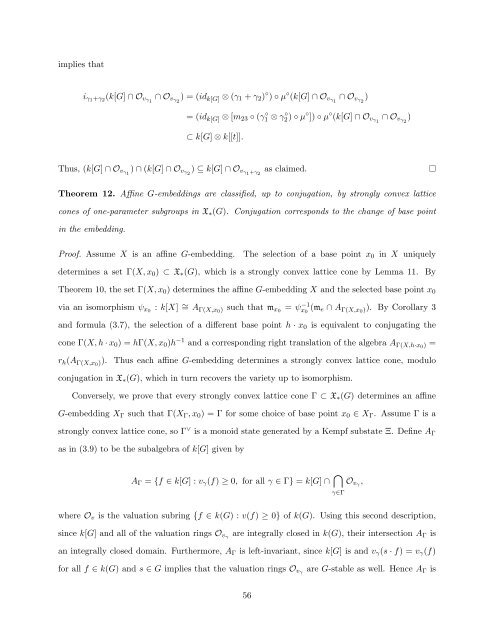Equivariant Embeddings of Algebraic Groups
Equivariant Embeddings of Algebraic Groups
Equivariant Embeddings of Algebraic Groups
Create successful ePaper yourself
Turn your PDF publications into a flip-book with our unique Google optimized e-Paper software.
implies that<br />
i γ1 +γ 2<br />
(k[G] ∩ O vγ1 ∩ O vγ2 ) = (id k[G] ⊗ (γ 1 + γ 2 ) ◦ ) ◦ µ ◦ (k[G] ∩ O vγ1 ∩ O vγ2 )<br />
= (id k[G] ⊗ [m 23 ◦ (γ ◦ 1 ⊗ γ ◦ 2) ◦ µ ◦ ]) ◦ µ ◦ (k[G] ∩ O vγ1 ∩ O vγ2 )<br />
⊂ k[G] ⊗ k[[t]].<br />
Thus, (k[G] ∩ O vγ1 ) ∩ (k[G] ∩ O vγ2 ) ⊆ k[G] ∩ O vγ1 +γ 2<br />
as claimed.<br />
Theorem 12. Affine G-embeddings are classified, up to conjugation, by strongly convex lattice<br />
cones <strong>of</strong> one-parameter subgroups in X ∗ (G). Conjugation corresponds to the change <strong>of</strong> base point<br />
in the embedding.<br />
Pro<strong>of</strong>. Assume X is an affine G-embedding.<br />
The selection <strong>of</strong> a base point x 0 in X uniquely<br />
determines a set Γ(X, x 0 ) ⊂ X ∗ (G), which is a strongly convex lattice cone by Lemma 11. By<br />
Theorem 10, the set Γ(X, x 0 ) determines the affine G-embedding X and the selected base point x 0<br />
via an isomorphism ψ x0 : k[X] ∼ = A Γ(X,x0 ) such that m x0 = ψ −1<br />
x 0<br />
(m e ∩ A Γ(X,x0 )). By Corollary 3<br />
and formula (3.7), the selection <strong>of</strong> a different base point h · x 0 is equivalent to conjugating the<br />
cone Γ(X, h · x 0 ) = hΓ(X, x 0 )h −1 and a corresponding right translation <strong>of</strong> the algebra A Γ(X,h·x0 ) =<br />
r h (A Γ(X,x0 )).<br />
Thus each affine G-embedding determines a strongly convex lattice cone, modulo<br />
conjugation in X ∗ (G), which in turn recovers the variety up to isomorphism.<br />
Conversely, we prove that every strongly convex lattice cone Γ ⊂ X ∗ (G) determines an affine<br />
G-embedding X Γ such that Γ(X Γ , x 0 ) = Γ for some choice <strong>of</strong> base point x 0 ∈ X Γ . Assume Γ is a<br />
strongly convex lattice cone, so Γ ∨ is a monoid state generated by a Kempf substate Ξ. Define A Γ<br />
as in (3.9) to be the subalgebra <strong>of</strong> k[G] given by<br />
A Γ = {f ∈ k[G] : v γ (f) ≥ 0, for all γ ∈ Γ} = k[G] ∩ ⋂ γ∈Γ<br />
O vγ ,<br />
where O v is the valuation subring {f ∈ k(G) : v(f) ≥ 0} <strong>of</strong> k(G). Using this second description,<br />
since k[G] and all <strong>of</strong> the valuation rings O vγ<br />
are integrally closed in k(G), their intersection A Γ is<br />
an integrally closed domain. Furthermore, A Γ is left-invariant, since k[G] is and v γ (s · f) = v γ (f)<br />
for all f ∈ k(G) and s ∈ G implies that the valuation rings O vγ<br />
are G-stable as well. Hence A Γ is<br />
56
















